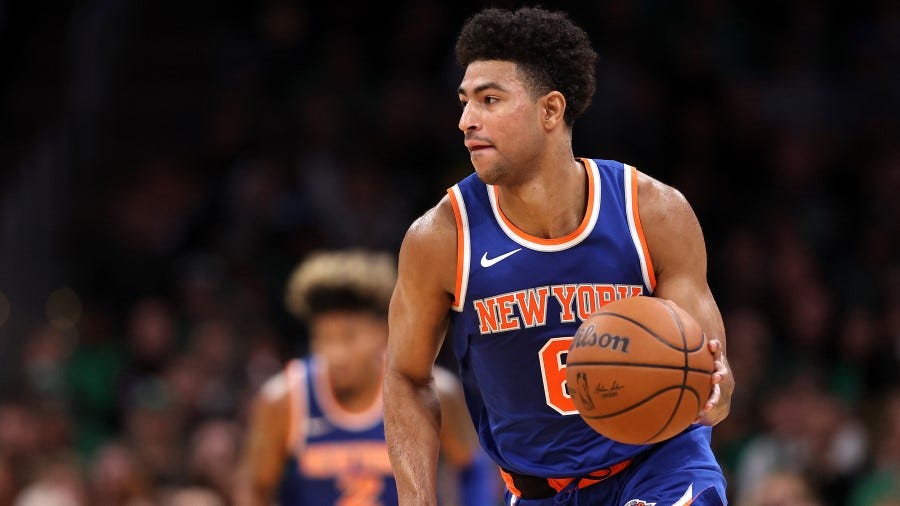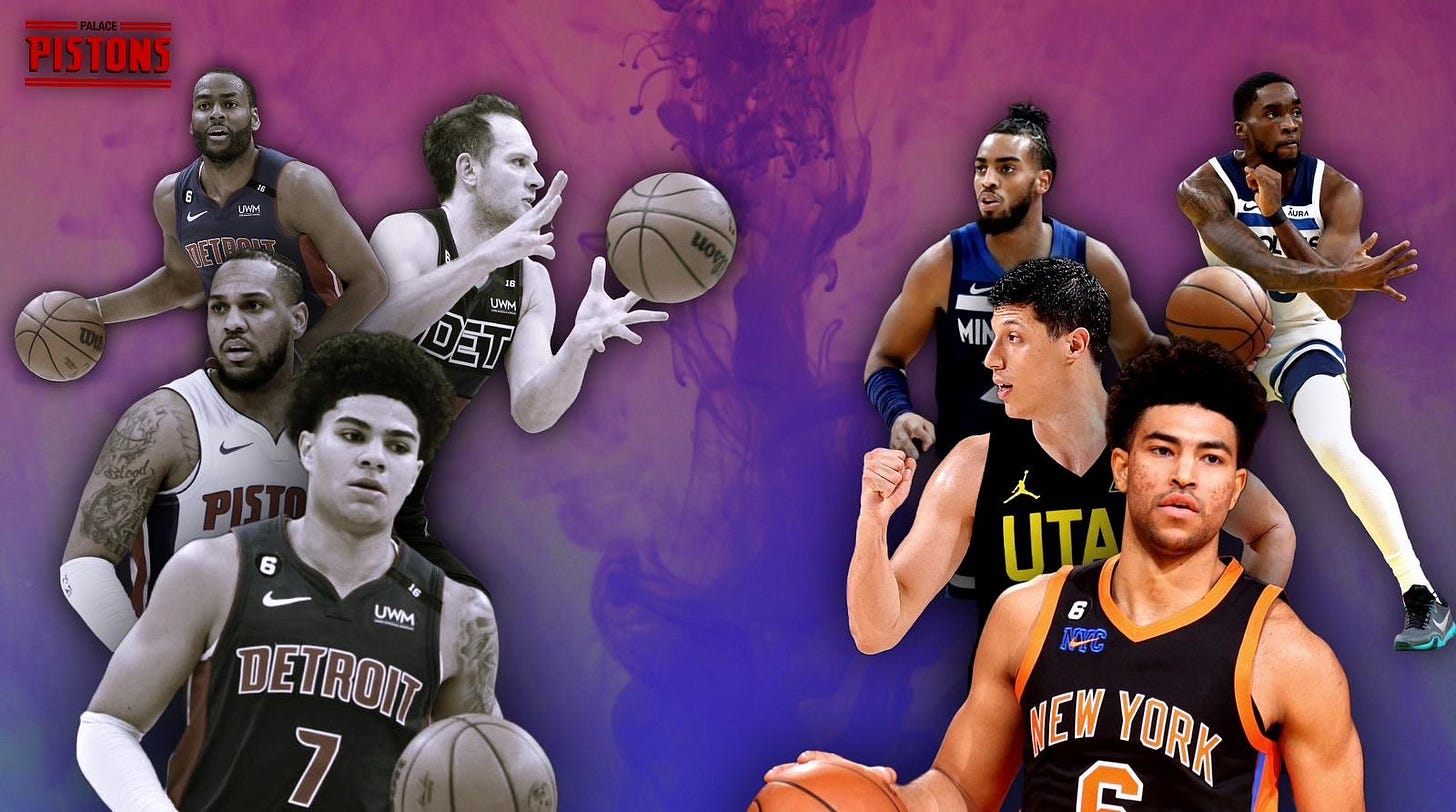Analyzing the Trade Deadline for the Detroit Pistons
Detroit needed to make some changes, and they certainly did that at the trade deadline.
The Detroit Pistons were the most active team at the NBA trade deadline, and for good reason. They are the worst team in the league, the punch line of many jokes, heck even people I know who don’t follow basketball were aware of the 28-game losing streak. The Pistons needed the most work out of all 30 teams in the NBA. And go to work they certainly did.
We’ve talked about Marvin Bagley and Isaiah Livers getting shipped to Washington for Danilo Gallinari and Mike Muscala, so read that if you haven’t yet. But something important came out of that move: The Pistons very clearly benefited by having the shooting prowess of Gallinari and Muscala on the roster.
By the front office pulling the plug on the Bagley experiment and finally realizing Livers would not live up to their idea of him, they acquired two bigs who could shoot the ball. Gallinari and Muscala are the extreme diet versions of the players that the Pistons need for the future: bigs and wings who can shoot the freaking basketball. Muscala and Gallinari are not starters even on the worst team in the league, but they do have skillsets that the Pistons quickly realized they need more of. This brings us to the first “deadline” deal.
Forza!
Detroit sent Kevin Knox and a Wizards second-round pick to the Utah Jazz for Italian Simone Fontecchio, a 6’7” wing who can shoot the freaking basketball. Sure, he’s 28 years old and might be older than the rest of the roster but he fits into a playoff roster puzzle.
For the Jazz, who were also competing for a playoff spot, Fontecchio averaged 8.9 points and 3.5 rebounds per game on 45% shooting and 39.1% from three-point range. His defense is passable at best, but he can get rebounds and hit threes. That is quite literally all the Pistons would need out of him. He isn’t a perfect player, but he is a guy that makes sense.
The Pistons also acquire his restricted free agency matching rights, so one would expect him to sign an extension in the Motor City.
Is it a sexy move? Of course not, but the Pistons were unwilling (as they should be) to include any of their prime prospects for marginal upgrades. Fontecchio is cheap and will get valuable playing time on a team that needs to be more outside inside of an offense as opposed to a completely clustered cramped mess.
The Quickest Hour
Monte Morris was on the court for about an hour of game time in a Pistons jersey, and what an hour it was. Morris was shipped to the Minnesota Timberwolves for Troy Brown Jr., Shake Milton, and a 2030 second-round draft pick. Yeah, 2030. Hopefully, the Pistons will be a playoff team by then.
Morris is a solid veteran who can shoot and orchestrate an offense. He doesn’t turn the ball over either, which is critical for a Wolves team that averages the fourth-most turnovers per game. It’s a good move for Minnesota, and it’s a fine move for Detroit. Milton and Brown are both on non-guaranteed contracts and the 2030 pick is so far away it may not even matter.
House Call
In a very small move that means very little, the Philadelphia 76ers sent Danuel House and a second-round pick to the Pistons. House was waived and will reportedly be a high priority for contenders. This does not do much for the Pistons, hence why this part is only two sentences.
The Big One
Oh boy, here we go. The Pistons pulled the trigger, one that they have been waffling with for well over a year. Detroit traded Bojan Bogdanovic and Alec Burks to the New York Knicks for Quinten Grimes, Ryan Arcidiacono, Malachi Flynn, and two second-round picks.
Wow.
The Pistons gave up the two best players in this deal, that much is certain. Bogdanovic and Burks were integral to Detroit’s offense and at times the only offense on the floor over the last few years. In return, they received salary filler, an enticing three-and-D wing, and two more draft picks to refill the cupboard. Is that enough?
In reality, probably not. If you believe Troy Weaver and the traditional Pistons beat writers, they could have gotten two first-round picks at last year’s deadline. That would have been much, much better of a return even if there were protections on the picks.
Arcidiacano and Flynn do nothing for me, with the former already being released by the team. Flynn was traded from Toronto as part of the OG Anunoby deal, and it would be surprising to see him stick with the Pistons considering how they don’t use their G League to maximum efficiency. Or, any level of efficiency.
But let’s be positive. Grimes is an intriguing player who profiles as exactly what Detroit needs on the roster. His defense is tenacious and should be very helpful in bringing the Pistons up to respectability on that end. He has good lateral quickness and the Knicks’ defense has been better with him on the court versus off. Admittedly, Grimes has had a down season in New York but he has also been in and out of the rotation and, lately, stapled to the bench.

With Detroit, Grimes will get a chance to develop with a young roster and under a coach who has experience with wings. It’s the kind of high-upside move that the Pistons should be making.
The reason this trade hurts so much is that the Knicks own Detroit’s first-round pick in protection hell for the next several years. Had the Pistons gotten that pick back, it would have opened up myriad possibilities to move future first-rounders to improve the team. Instead, the Pistons are still handicapped.
The Cuts
This may be the most noteworthy part of the entire deadline. In addition to Arcidiacano, Detroit cut Joe Harris, who was their “big” cap space addition this past summer, Gallinari, who will pursue a team capable of winning a championship, and…
…Killian. Freaking. Hayes.
Yes, that Killian Hayes (there isn’t another one). The former seventh-overall pick in the NBA Draft. The second piece of the French Connection with Sekou Doumbouya is another failure. Monty Williams’ favorite future son-in-law.
That one. That Killian Hayes.
After being the league-wide punching bag player on the league-wide punching bag team, Hayes and the Pistons have finally parted ways. It was a series of ups, like maybe five of them, and a whole lot of downs. Weaver said this in his post-deadline press conference about Hayes:
"It didn't work. He has size, is a versatile defender, and playmaker. It didn't work because of the shooting. He can defend, and make plays. But if you're a guard in the NBA, you've got to make shots.”
That is the long and short of it with Hayes. He profiled as a big guard who could defend, orchestrate an offense, and be able to score from at least two levels. Instead, he looked afraid to shoot, bad when he did shoot, and really could not be kept on the floor because of it. Another team will have to take a chance on him and see if they can unlock the potential that the Pistons, and Kevin O’Connor, saw.
So Detroit’s roster is pretty much set in stone. The young core will play a whole lot, the veterans will teach them things, and hopefully, a picture will be painted of how the team should operate next year. Jaden Ivey should continue getting better. Cade Cunningham is already a star. Jalen Duren is a solid, young center who needs more time to grow up. Ausar Thompson has sky-high potential if he can develop a three-pointer. Those are the things that matter the most, and those are the things that have mattered the most all season.
The Pistons pulled the plug on some things, a few of which were too late. But they swallowed the pride, admitted mistakes, and have a much more clear picture of what the future should hold. That is a win that won’t show up in the standings but should be regarded as one nonetheless.



